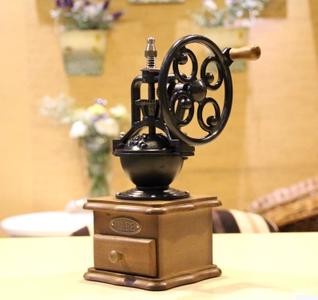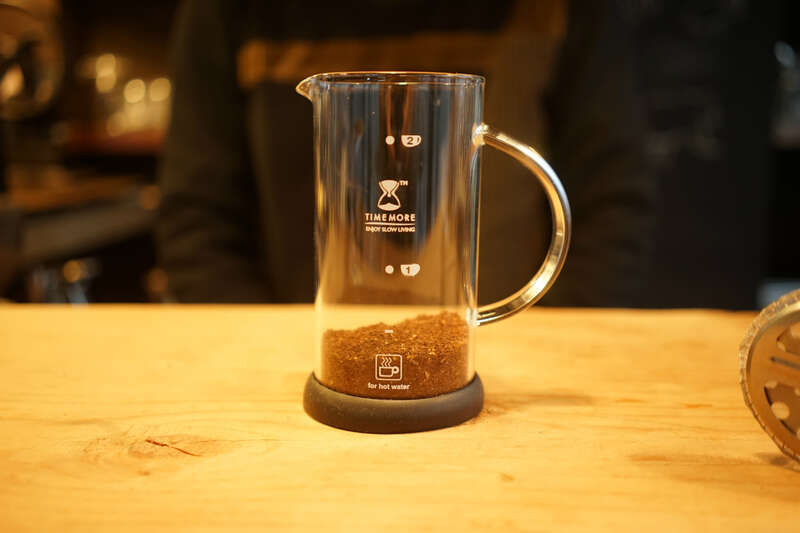Coffee lessons, manual grinder usage
Follow the caf é (Wechat official account vdailycom) and found that Beautiful Cafe opened a small shop of its own.
Use steps
First, unscrew the metal nut above the hand grinder.
2. Remove the handle from the hand grinder
Third, remove the fixed metal card above the hand mill fineness adjusting screw
Fourth, the left hand tightens the fixed column in the middle of the hand grinder so that it cannot be rotated left and right. If the right hand rotates the thickness adjustment nut, the degree of grinding will become thinner if it rotates downward, and thicker if it rotates upward. In this process, you should put on the rotating handle from time to time, and take some coffee beans for grinding and observe whether the thickness meets the needs.
5. Reinstall the handle and tighten the nut above.

Related readings:
Manual grinder:
There are generally two kinds of manual bean grinders, one is the "fiat plate burr grinder" of the grinding plate on the sawtooth, which is distributed up and down like a grinding plate, and the other is the "conical burr grinder" of the funnel-shaped sawtooth embedded on the grinding board of the other surface. The difference lies in the horizontal and longitudinal of the sawtooth. Compared with the horizontal, the longitudinal sawtooth has a wider grinding area, so the grinding can be completed faster with fewer rotations.
Common shapes are cylindrical like a ground pepper bottle, or a drawer box. Put the coffee on a plate under the handle, rotate the handle, and the ground coffee will pile up in the drawer.
The handle consists of five parts: the thickness adjustment screw, the inspection fixing ring, the A shape thickness adjustment fixing screw, the handle and the main fixing screw. According to different types, some machines need to separate and disassemble the above parts in order to adjust the thickness adjustment screws, and then reassemble them for use, and there are also machines that can directly adjust the thickness adjustment screws. If you rotate the thickness adjustment screw clockwise, you can grind a finer coffee, and if you rotate counterclockwise, you can grind a thicker particle.
If you want to grind the particles for espresso, you can grind the ground coffee again, but if you want to grind into the ultra-fine extra of Turkish coffee, it is better to use a special grinder for Turkish coffee or an electric grinder.
In order to keep the coffee from remaining in the used coffee grinder, remember to clean it up with a brush.
Electric grinder:
Electric grinder has sawtooth type and rotary wing type. The sawtooth electric grinder grinds the coffee into an appropriate thickness and then puts it in a basket, and is equipped with thick and thin buttons, which can automatically set the size. Most of these electric grinders are expensive products.
The electric grinder mainly used in ordinary bulk is the mini rotary wing grinder, which is very similar to the bean mixer for grinding dietary beans. Since there is no device to adjust the size of the rotor electric grinder, if you want to grind to the desired thickness, it can be adjusted by time.
In particular, if you want to use a rotary wing electric grinder to grind uniform coffee particles, shaking the grinder up and down is the key point! It is important to grind the coffee to the desired size while confirming the process and appearance of the grinding, but if you are proficient to a certain degree, you can tell the thickness of the particles by the sound you make when shaking. It's not that sound, and it's not this voice. It may sound like advertising copywriting, but in fact, the finer the particles, the lighter the sound.
The coffee grounds left in the grinder will oxidize after a long time, affecting the next use, so remember to clean the used grinder with a brush, or rinse it with water and dry it for storage.
Important Notice :
前街咖啡 FrontStreet Coffee has moved to new addredd:
FrontStreet Coffee Address: 315,Donghua East Road,GuangZhou
Tel:020 38364473
- Prev

Why do you want to be a barista for the meaning of being a coffee master?
For baristas, the barista competition is a new world. Although the national barista competition has been held in China for more than 10 years, the number of barista competitions is still limited, and only the champion can be promoted to participate in higher-level competitions. For example, in the World Barista Competition, each participating province in the country sends a locally selected champion.
- Next

Coffee course knowledge, using the method to press the pot to make coffee
Among the many coffee utensils, the French pressure pot is undoubtedly the first simple and convenient extraction.
Related
- What is the meaning of lactic acid fermentation with coffee bean treatment?
- How to judge the state of foam by sound?
- How does the latte pull out the unicorn pattern? Come to get for a little trick to improve the flower pull!
- Will flower pulling affect the taste of the latte?
- Do you know the history of coffee?
- The difference between honey treatment and sun washing what is raisin honey treatment?
- What kind of milk can a novice use to make coffee foam to keep the foam longer? The correct method and skills of milking tutorial sharing
- Why do washed coffee beans taste sour? Flavor characteristics of washed Coffee
- Introduction to the skill of how to practice the size and height of water injection around the circle of hand-brewed coffee
- How do beginners practice coffee flower drawing from scratch?

